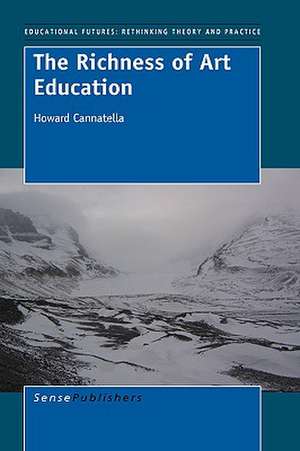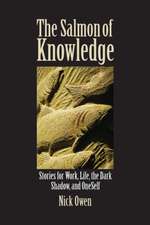The Richness of Art Education
Autor Howard Cannatellaen Limba Engleză Hardback – 30 noi 2008
| Toate formatele și edițiile | Preț | Express |
|---|---|---|
| Paperback (1) | 381.00 lei 38-44 zile | |
| Brill – 31 dec 2007 | 381.00 lei 38-44 zile | |
| Hardback (1) | 559.07 lei 38-44 zile | |
| Sense Publishers – 30 noi 2008 | 559.07 lei 38-44 zile |
Preț: 559.07 lei
Preț vechi: 690.21 lei
-19% Nou
Puncte Express: 839
Preț estimativ în valută:
106.98€ • 111.92$ • 88.87£
106.98€ • 111.92$ • 88.87£
Carte tipărită la comandă
Livrare economică 29 martie-04 aprilie
Preluare comenzi: 021 569.72.76
Specificații
ISBN-13: 9789087906085
ISBN-10: 9087906080
Pagini: 136
Dimensiuni: 156 x 234 x 10 mm
Greutate: 0.37 kg
Editura: Sense Publishers
Locul publicării:Netherlands
ISBN-10: 9087906080
Pagini: 136
Dimensiuni: 156 x 234 x 10 mm
Greutate: 0.37 kg
Editura: Sense Publishers
Locul publicării:Netherlands
Descriere
Descriere de la o altă ediție sau format:
This book is intended for anyone interested in knowing more about arts education. It makes a daring contribution to the subject in a clear, pragmatic, committed and ambitious way. The book discusses thoroughly the theory and practice of arts education and what it means to be a teacher of art. It is a powerful and inspiring account of the challenges of teaching in the arts that will appeal to anyone in the teaching profession. With clarity and engagement, The Richness of Arts Education ddresses what it means to be a teacher in the arts. Familiarity and knowledge of teaching is checked by the constant relevant examples that the book critically explores. The book rethinks some of the real ground of teaching in the arts and encourages a deeper understanding of them. Primary and secondary teachers, college and university teachers and policy makers will find this book formidable. It is a book for today and tomorrow.
Howard Canatella’s The Richness of Arts Education provides a deep philosophical engagement with the arts and art education. And if that were not enough, it also provides a sustained discussion of the ways in which art education enriches our philosophical understanding of the arts specifically, education certainly, but also some key issues within philosophy itself. In other words, Canatella adequately demonstrates the riches that art education entails. While the key figures he engages with do not encompass the entire range of possible philosophical perspectives that could be brought to bear on the field of art education—an impossible task in any case—he engages each figure deeply. The scholarly literature in each section is thoroughly explored to highlight the thesis that holds the entire project together—the deeply textured quality of art education and the many benefits that we can derive thereof. This should be a valuable book to art teachers no doubt, but to educators and philosophers too.
This book is intended for anyone interested in knowing more about arts education. It makes a daring contribution to the subject in a clear, pragmatic, committed and ambitious way. The book discusses thoroughly the theory and practice of arts education and what it means to be a teacher of art. It is a powerful and inspiring account of the challenges of teaching in the arts that will appeal to anyone in the teaching profession. With clarity and engagement, The Richness of Arts Education ddresses what it means to be a teacher in the arts. Familiarity and knowledge of teaching is checked by the constant relevant examples that the book critically explores. The book rethinks some of the real ground of teaching in the arts and encourages a deeper understanding of them. Primary and secondary teachers, college and university teachers and policy makers will find this book formidable. It is a book for today and tomorrow.
Howard Canatella’s The Richness of Arts Education provides a deep philosophical engagement with the arts and art education. And if that were not enough, it also provides a sustained discussion of the ways in which art education enriches our philosophical understanding of the arts specifically, education certainly, but also some key issues within philosophy itself. In other words, Canatella adequately demonstrates the riches that art education entails. While the key figures he engages with do not encompass the entire range of possible philosophical perspectives that could be brought to bear on the field of art education—an impossible task in any case—he engages each figure deeply. The scholarly literature in each section is thoroughly explored to highlight the thesis that holds the entire project together—the deeply textured quality of art education and the many benefits that we can derive thereof. This should be a valuable book to art teachers no doubt, but to educators and philosophers too.














